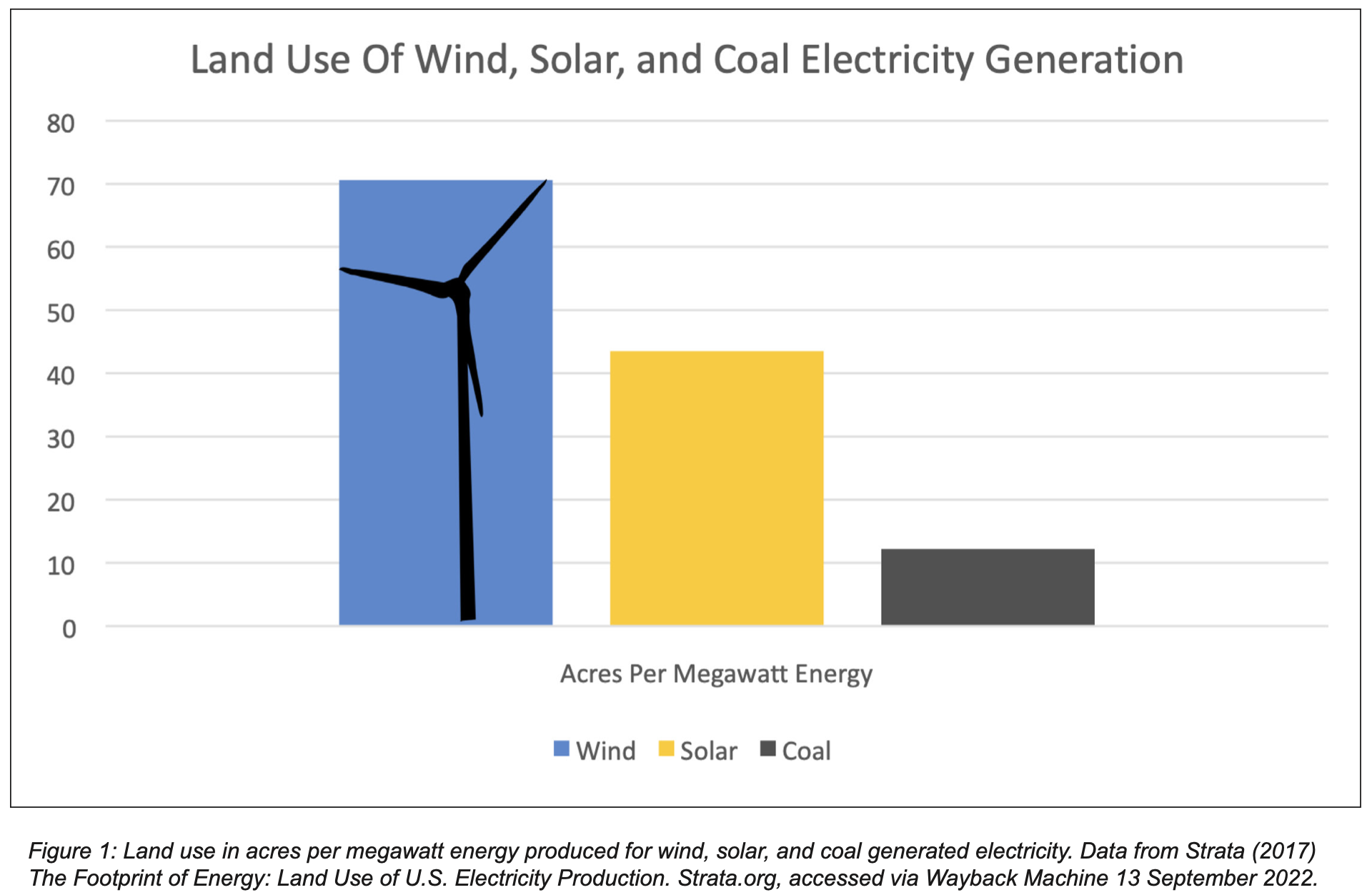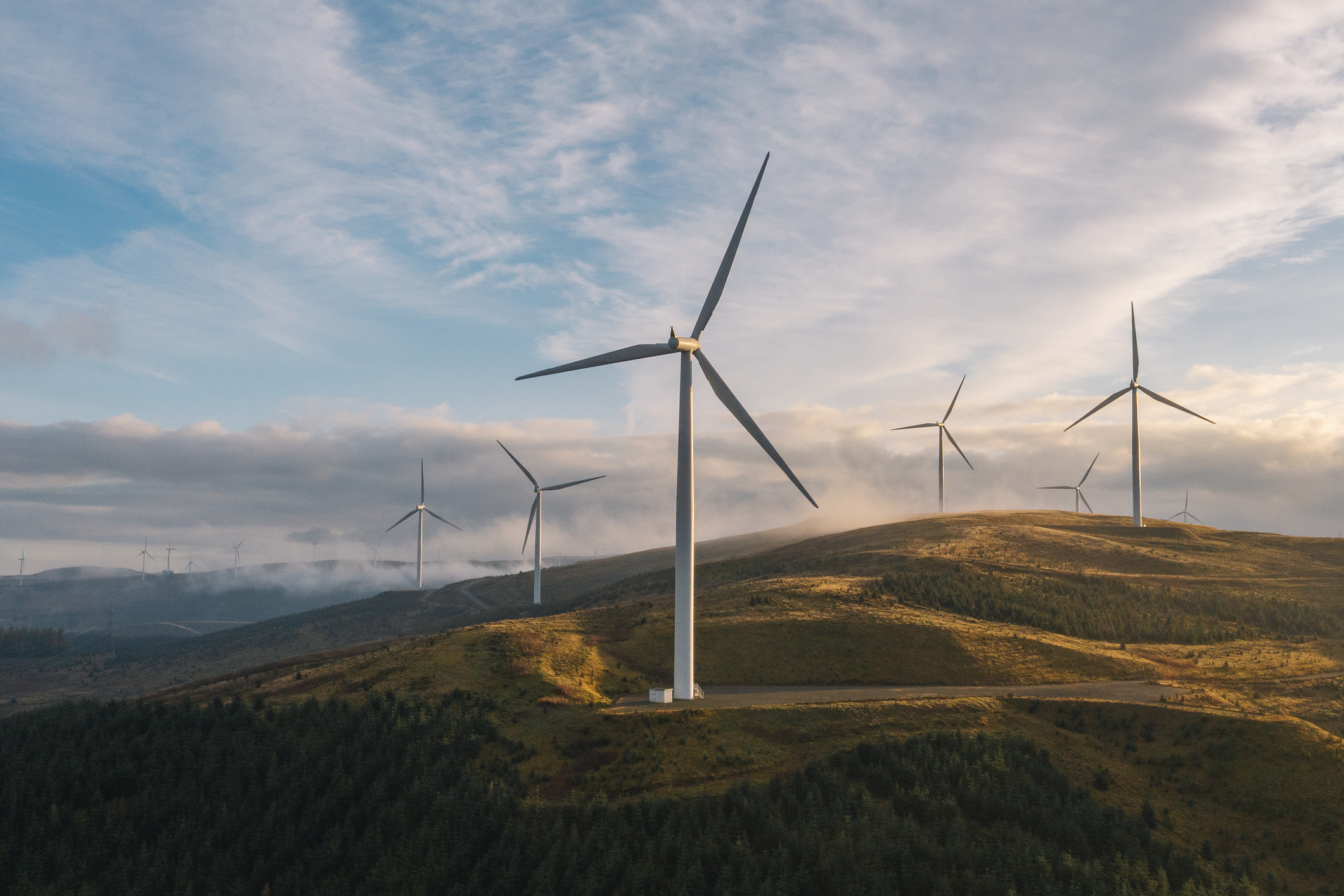“Wind turbines require enormous amounts of land, mineral resources, and kill millions of birds and bats. ”
To read the original PDF, click here.
Quick Bullets
- Generating electricity using wind turbines does not produce any emissions of carbon dioxide or other gases during operations, but the mining and refining of critical minerals necessary for wind turbine production and operation produce substantial air and water pollution as well as carbon dioxide emissions.
- Industrial scale wind facilities require developing massive amounts of land, much more than traditional power generating sources, and they require a much larger volume of critical minerals than any other power source. [1]
- Wind turbines kill millions of birds and bats every year, including protected eagles, raptors, and endangered bats. [2]
Land Use and Mining
Wind turbines do not produce any direct carbon dioxide emissions during operation; however, they do produce a variety of negative environmental impacts.
Land use is a major sticking point for the growth of industrial wind facilities in the United States, with local governments resisting encroachment in rural areas throughout the country. [3] Although individual towers have a relatively small footprint, studies suggest the total land use and environmental impact of wind farms throughout the county is considerable.
The amount of space required to produce 1,000 megawatts (MW) from an industrial wind facility can exceed 133 square miles of land, compared to just 1.3 square miles needed for an equivalent nuclear power plant. Wind turbines also require enormous amounts of rare earth elements like neodymium magnets, around 377 pounds of neodymium per MW capacity. The mining for these resources destroys huge amounts of land and requires heavy machinery that do emit copious amounts of carbon dioxide emissions as well as traditional pollutants. The land required for new transmission lines is also substantial at about 10.4 acres per MW. [4]
Replacing current electricity generation with wind power may require covering 1/3 of the American land mass with wind turbines, and electrifying all transportation would increase that number to 1/2.[5] The environmental and ecological impacts of developing that much land with wind turbines would be catastrophic. Replacing current electricity with wind turbines may also raise net temperatures in the United States through the end of the century. [6]
Wind turbine blades cannot be recycled, and therefore most end up in landfills. Industrial wind facilities could produce 43 million tons of blade waste throughout the world by 2050. [7
The most viable locations, where winds blow relatively constantly at desired speeds, are filling up fast, meaning future wind projects will be less efficient. Larger wind projects with more turbines will be required to generate the same amount of power as existing facilities. Also, the power output of wind facilities that are downwind neighbors of other large turbine fields can decrease by 20 percent or more due to reduced wind flow between turbines. [8]

Effects on Humans and Wildlife
In the United States, as long as certain requirements are followed, the federal government has granted wind companies special permission to kill Bald eagles, Golden eagles, and other raptors, which are normally protected under various federal laws. [9] In February of 2022, the U.S. Fish and Wildlife Service increased the number of eagles the wind industry can kill by more than four times the original allotment. [10]
In 2012, when there were thousands fewer turbines than today, wind turbines killed an estimated 573,000 birds in the United States, with 83,000 being raptors. [11] Every year, for example, a single industrial wind facility in California kills between 75 and 110 Golden eagles. [12] Wind facilities especially threaten migratory birds because the best sites for power generation coincide with migration routes.
Wind facilities also kill up to 888,000 bats each year. [13] The Hoary bat alone may lose 90 percent of its population over the next 50 years due to wind turbine impacts. [14]
In terms of human health effects, the constant infrasound and low frequency noise produced by wind turbines, while not always audible, can cause health issues including sleeplessness and even heart problems, if appropriate setbacks are not maintained. [15] Infrasound likely has a similar effect on animals living too close to turbines. This is also a problem for migrating whales where offshore wind facilities exist, are under construction, or being planned. [16, 17]
Endnotes
[1] Bastasch, M. (2019, April 11). ‘vacant land myth’: Hundreds of us localities are resisting the spread of green energy. The Daily Caller. Retrieved September 15, 2022, from
https://dailycaller.com/2019/04/11/us-green-energy-land-myth/
[2] Avian mortality. Golden Gate Audubon Society. (2020, August 12). Retrieved September 15, 2022, from https://goldengateaudubon. org/conservation/birds-at-risk/avian-mortality-at-altamont-pass/
[3] Smallwood, K. S. (2013). Comparing bird and bat fatality-rate estimates among North American wind-energy projects. Wildlife Society Bulletin, 37(1), 19–33.
https://doi.org/10.1002/wsb.260
[4] American Eagle Foundation. (n.d.). Conventional Wind Energy – A Design Deadly for Birds. Eagles.org. Retrieved September 15, 2022, from
https://www.eagles.org/take-action/wind-turbine-fatalities/
[5] Jemison, M. (2017, March 7). Wind Turbine Blades could decimate North America’s most widespread bat species. Nature Today. Retrieved September 15, 2022, from
https://www.naturetoday.com/intl/en/nature-reports/message/?msg=23294
[6] Smallwood, K.S. (2013)
[7] Stevens, L., Anderson, B., Cowan, C., Colton, K., & Johnson, D. (2017, June). The Footprint of Energy: Land Use of U.S. Electricity Production. Strata.org. Retrieved from
https://web.archive.org/web/20200215074838/https:/www.strata.org/pdf/2017/footprints-full.pdf
[8] Stella, C. (2019, September 10). Unfurling the waste problem caused by wind energy. NPR. Retrieved September 15, 2022, from
https://www.npr.org/2019/09/10/759376113/unfurling-the-waste-problem-caused-by-wind-energy
[9] Flanakin, D. (2020, September 28). Wind turbines generate mountains of waste. The Heartland Institute. Retrieved September 15, 2022, from
https://www.heartland.org/news-opinion/news/wind-turbines-generate-mountains-of-waste
[10] Hereonhelmholtz, H.-Z. (2021, June 3). Are wind farms slowing each other down? EurekAlert! Retrieved September 15, 2022, from
https://www.eurekalert.org/news-releases/485794
[11] Carrington, D. (2015, September 1). Wind Farm Project Could Disrupt radar. Carolina Journal. Retrieved September 15, 2022, from
https://www.carolinajournal.com/wind-farm-project-could-disrupt-radar/
[12] Associated Press. (2015, February 2). Obama administration gives wind farms a pass on eagle deaths, prosecutes oil companies. Fox News. Retrieved September 15, 2022, from
https://www.foxnews.com/politics/obama-administration-gives-wind-farms-a-pass-oneagle-deaths-prosecutes-oil-companies
[13] FWS increases take limits for Eagle permits. DGS Law. (2022, February 8). Retrieved September 15, 2022, from
https://www.dgslaw.com/news-events/fws-increases-take-limits-for-eagle-permits
[14] Jemison, M. (2017, March 7).
[15] Chiu, C.-H., Lung, S.-C. C., Chen, N., Hwang, J.-S., & Tsou, M.-C. M. (2021, September 8). Effects of low-frequency noise from wind turbines on heart rate variability in healthy individuals. Nature News. Retrieved September 15, 2022, from
https://www.nature.com/articles/s41598-021-97107-8
[16] Agnew, R. C. N., Smith, V. J., & Fowkes, R. C. (2016, June 26). Wind in the gallows: Study shows Badgers suffer merciless stress & torment from Wind Turbine Noise & Vibration. Stop These Things. Retrieved September 15, 2022, from https://stopthesethings. com/2016/06/06/wind-in-the-gallows-study-shows-badgers-suffer-merciless-stress-torment-from-wind-turbine-noise-vibration/
[17] Driessen, P. (2016, March 4). Are wind turbines killing whales? CFACT. Retrieved September 15, 2022, from https://www.cfact. org/2016/03/04/are-wind-turbines-killing-whales/
“Wind turbines require enormous amounts of land, mineral resources, and kill millions of birds and bats. ”
To read the original PDF, click here.
Quick Bullets
- Generating electricity using wind turbines does not produce any emissions of carbon dioxide or other gases during operations, but the mining and refining of critical minerals necessary for wind turbine production and operation produce substantial air and water pollution as well as carbon dioxide emissions.
- Industrial scale wind facilities require developing massive amounts of land, much more than traditional power generating sources, and they require a much larger volume of critical minerals than any other power source. [1]
- Wind turbines kill millions of birds and bats every year, including protected eagles, raptors, and endangered bats. [2]
Land Use and Mining
Wind turbines do not produce any direct carbon dioxide emissions during operation; however, they do produce a variety of negative environmental impacts.
Land use is a major sticking point for the growth of industrial wind facilities in the United States, with local governments resisting encroachment in rural areas throughout the country. [3] Although individual towers have a relatively small footprint, studies suggest the total land use and environmental impact of wind farms throughout the county is considerable.
The amount of space required to produce 1,000 megawatts (MW) from an industrial wind facility can exceed 133 square miles of land, compared to just 1.3 square miles needed for an equivalent nuclear power plant. Wind turbines also require enormous amounts of rare earth elements like neodymium magnets, around 377 pounds of neodymium per MW capacity. The mining for these resources destroys huge amounts of land and requires heavy machinery that do emit copious amounts of carbon dioxide emissions as well as traditional pollutants. The land required for new transmission lines is also substantial at about 10.4 acres per MW. [4]
Replacing current electricity generation with wind power may require covering 1/3 of the American land mass with wind turbines, and electrifying all transportation would increase that number to 1/2.[5] The environmental and ecological impacts of developing that much land with wind turbines would be catastrophic. Replacing current electricity with wind turbines may also raise net temperatures in the United States through the end of the century. [6]
Wind turbine blades cannot be recycled, and therefore most end up in landfills. Industrial wind facilities could produce 43 million tons of blade waste throughout the world by 2050. [7
The most viable locations, where winds blow relatively constantly at desired speeds, are filling up fast, meaning future wind projects will be less efficient. Larger wind projects with more turbines will be required to generate the same amount of power as existing facilities. Also, the power output of wind facilities that are downwind neighbors of other large turbine fields can decrease by 20 percent or more due to reduced wind flow between turbines. [8]

Effects on Humans and Wildlife
In the United States, as long as certain requirements are followed, the federal government has granted wind companies special permission to kill Bald eagles, Golden eagles, and other raptors, which are normally protected under various federal laws. [9] In February of 2022, the U.S. Fish and Wildlife Service increased the number of eagles the wind industry can kill by more than four times the original allotment. [10]
In 2012, when there were thousands fewer turbines than today, wind turbines killed an estimated 573,000 birds in the United States, with 83,000 being raptors. [11] Every year, for example, a single industrial wind facility in California kills between 75 and 110 Golden eagles. [12] Wind facilities especially threaten migratory birds because the best sites for power generation coincide with migration routes.
Wind facilities also kill up to 888,000 bats each year. [13] The Hoary bat alone may lose 90 percent of its population over the next 50 years due to wind turbine impacts. [14]
In terms of human health effects, the constant infrasound and low frequency noise produced by wind turbines, while not always audible, can cause health issues including sleeplessness and even heart problems, if appropriate setbacks are not maintained. [15] Infrasound likely has a similar effect on animals living too close to turbines. This is also a problem for migrating whales where offshore wind facilities exist, are under construction, or being planned. [16, 17]
Endnotes
[1] Bastasch, M. (2019, April 11). ‘vacant land myth’: Hundreds of us localities are resisting the spread of green energy. The Daily Caller. Retrieved September 15, 2022, from
https://dailycaller.com/2019/04/11/us-green-energy-land-myth/
[2] Avian mortality. Golden Gate Audubon Society. (2020, August 12). Retrieved September 15, 2022, from https://goldengateaudubon. org/conservation/birds-at-risk/avian-mortality-at-altamont-pass/
[3] Smallwood, K. S. (2013). Comparing bird and bat fatality-rate estimates among North American wind-energy projects. Wildlife Society Bulletin, 37(1), 19–33.
https://doi.org/10.1002/wsb.260
[4] American Eagle Foundation. (n.d.). Conventional Wind Energy – A Design Deadly for Birds. Eagles.org. Retrieved September 15, 2022, from
https://www.eagles.org/take-action/wind-turbine-fatalities/
[5] Jemison, M. (2017, March 7). Wind Turbine Blades could decimate North America’s most widespread bat species. Nature Today. Retrieved September 15, 2022, from
https://www.naturetoday.com/intl/en/nature-reports/message/?msg=23294
[6] Smallwood, K.S. (2013)
[7] Stevens, L., Anderson, B., Cowan, C., Colton, K., & Johnson, D. (2017, June). The Footprint of Energy: Land Use of U.S. Electricity Production. Strata.org. Retrieved from
https://web.archive.org/web/20200215074838/https:/www.strata.org/pdf/2017/footprints-full.pdf
[8] Stella, C. (2019, September 10). Unfurling the waste problem caused by wind energy. NPR. Retrieved September 15, 2022, from
https://www.npr.org/2019/09/10/759376113/unfurling-the-waste-problem-caused-by-wind-energy
[9] Flanakin, D. (2020, September 28). Wind turbines generate mountains of waste. The Heartland Institute. Retrieved September 15, 2022, from
https://www.heartland.org/news-opinion/news/wind-turbines-generate-mountains-of-waste
[10] Hereonhelmholtz, H.-Z. (2021, June 3). Are wind farms slowing each other down? EurekAlert! Retrieved September 15, 2022, from
https://www.eurekalert.org/news-releases/485794
[11] Carrington, D. (2015, September 1). Wind Farm Project Could Disrupt radar. Carolina Journal. Retrieved September 15, 2022, from
https://www.carolinajournal.com/wind-farm-project-could-disrupt-radar/
[12] Associated Press. (2015, February 2). Obama administration gives wind farms a pass on eagle deaths, prosecutes oil companies. Fox News. Retrieved September 15, 2022, from
https://www.foxnews.com/politics/obama-administration-gives-wind-farms-a-pass-oneagle-deaths-prosecutes-oil-companies
[13] FWS increases take limits for Eagle permits. DGS Law. (2022, February 8). Retrieved September 15, 2022, from
https://www.dgslaw.com/news-events/fws-increases-take-limits-for-eagle-permits
[14] Jemison, M. (2017, March 7).
[15] Chiu, C.-H., Lung, S.-C. C., Chen, N., Hwang, J.-S., & Tsou, M.-C. M. (2021, September 8). Effects of low-frequency noise from wind turbines on heart rate variability in healthy individuals. Nature News. Retrieved September 15, 2022, from
https://www.nature.com/articles/s41598-021-97107-8
[16] Agnew, R. C. N., Smith, V. J., & Fowkes, R. C. (2016, June 26). Wind in the gallows: Study shows Badgers suffer merciless stress & torment from Wind Turbine Noise & Vibration. Stop These Things. Retrieved September 15, 2022, from https://stopthesethings. com/2016/06/06/wind-in-the-gallows-study-shows-badgers-suffer-merciless-stress-torment-from-wind-turbine-noise-vibration/
[17] Driessen, P. (2016, March 4). Are wind turbines killing whales? CFACT. Retrieved September 15, 2022, from https://www.cfact. org/2016/03/04/are-wind-turbines-killing-whales/


